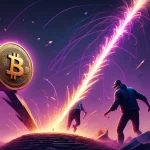XRP Soars 24% to $3.27: ETF Launch, California Support, and Wild 2025 Price Forecasts

XRP Surges 24% to Multi-Year High: ETF Listings, Government Support, and 2025 Price Predictions
XRP has ignited the crypto market with a stunning 24% price jump in just a week, soaring to a multi-year high of $3.27 and pushing its market cap beyond $190 billion. Is this a turning point for Ripple’s oft-debated token, or a fleeting hype bubble ripe for a pop? Let’s break it down with the facts, the catalysts, and the skepticism this wild ride deserves.
- Price Rally: XRP spikes 24% to $3.27, with a market cap topping $190 billion, marking a 126% rise since April lows.
- Institutional Milestone: ProShares Ultra XRP ETF launches on NYSE, the first of its kind on a major U.S. exchange.
- Government Backing: California Breakthrough Project kicks off at Ripple’s HQ, signaling blockchain’s public sector potential.
The XRP Surge: A Perfect Storm of Momentum
As of mid-2025, XRP, the digital asset tied to Ripple’s cross-border payment protocol, is trading at $3.25—barely 15% below its all-time high of $3.84 from January 2018. This isn’t just a random pump; it’s a 126% climb from April’s lows, bulldozing through key resistance levels between $2.50 and $3.00 with ease. Market enthusiasm is palpable, with perpetual futures open interest hitting a record $8.8 billion—equivalent to nearly 2.9 billion XRP in leveraged contracts. That’s a massive speculative bet, fueling both potential upside and the risk of a savage correction if the mood sours. So, what’s behind this rally? Two heavyweight catalysts are driving the narrative: a groundbreaking ETF listing and a rare governmental nod, paired with technical patterns that have chartists drooling.
Institutional Legitimacy: The XRP ETF Breakthrough
On July 18, 2025, the ProShares Ultra XRP ETF debuted on the New York Stock Exchange, marking the first XRP-linked exchange-traded fund on a major U.S. platform. This isn’t a minor footnote; it’s a seismic shift for altcoins beyond Bitcoin and Ethereum. Hedge funds, registered investment advisors, and mutual funds now have a regulated pathway to gain exposure to XRP’s price action, albeit with a 2x leverage kicker. That leverage amplifies returns but also risks—think futures market drag (where funds underperform due to rolling contracts at unfavorable prices) and tracking errors that can erode gains over time. Unlike a spot ETF, which would directly track XRP’s price, this leveraged product is more of a short-term tactical tool than a long-term hold. Still, the symbolism is undeniable: XRP is gaining traction with traditional finance, a far cry from years of regulatory limbo. Could a spot XRP ETF be next? If approved, it’d likely spark even bigger institutional inflows, further cementing XRP’s place in the mainstream crypto lineup, as discussed in this Reddit thread on ETF potential.
Government Endorsement: California’s Blockchain Push
Adding fuel to the fire, California Governor Gavin Newsom launched the California Breakthrough Project on June 6, 2025, right at Ripple’s headquarters. This initiative aims to harness cutting-edge tech to streamline public services, and with California housing 32 of the world’s top 50 AI companies, it’s no small stage. Hosting this event at Ripple isn’t just a photo op—it’s a subtle endorsement of blockchain’s potential to disrupt bureaucratic gridlock.
“The Golden State continues to lead in efficiency, strategically implementing technologies and practices that make Californians’ lives better,” Newsom declared during the launch.
While it’s unclear if XRP itself plays a direct role in the project, Ripple’s tech—focused on fast, cheap cross-border transactions—aligns with goals of efficiency. For XRP, this ties into Ripple’s long-standing narrative of real-world utility, from remittances to potential central bank digital currency (CBDC) integrations. Yet, for purists in the decentralization camp, government involvement is a double-edged sword. Sure, it accelerates adoption, but are we just swapping one centralized overseer for another? It’s a question worth wrestling with as blockchain inches closer to the public sector, and some insights on this debate can be found in this Quora discussion on Ripple’s impact.
Technical Hype: Breakouts and Moonshot Predictions
On the charts, XRP is making waves. Analysts point to a breakout from a seven-year symmetrical triangle pattern—a formation where price swings tighten over time before exploding in one direction. This suggests a major shift after years of consolidation, backed by soaring trading volume. Using Fibonacci extensions (a tool to predict price targets based on past swings), near-term goals range from $4.70 to $6.48. Some even cite historical market cycles to forecast a ludicrous $22-23 by August 1, 2025. Let’s cut the fluff—these higher numbers feel like wishful thinking, akin to predicting Bitcoin at $1 million because “it’s due.” Without hard data, treat such claims with the caution you’d give a dodgy meme coin. More grounded comparisons, like Ethereum’s ETF-driven rallies, suggest $4.70 might be feasible if momentum holds, but crypto’s volatility keeps any prediction on shaky ground. For a deeper dive into these technical patterns, check out this Reddit analysis on XRP’s breakout.
Red Flags: Overbought Signals and Regulatory Shadows
Before you FOMO in, let’s talk risks. The Relative Strength Index (RSI), a momentum gauge measuring if an asset is overvalued or undervalued, sits above 80 for XRP—screaming “overbought” and hinting at a possible pullback. In sane markets, that’s a sell signal, but crypto often laughs at logic, sustaining parabolic runs longer than expected. Remember Dogecoin’s 2021 madness? Still, a correction could hit hard, especially with $8.8 billion in leveraged bets ready to unravel. Then there’s the SEC elephant in the room. Ripple’s legal battle, kicked off in 2020 over whether XRP is a security, hasn’t fully resolved despite recent wins and ETF approvals. Until total clarity emerges, regulatory uncertainty looms like a dark cloud. A harsh ruling could tank sentiment overnight, no matter how many ETFs or government handshakes XRP racks up. For more on what might come next, take a look at this prediction on XRP’s future price trajectory.
XRP vs. Bitcoin: Complementary or Conflicted?
For Bitcoin maximalists, XRP remains a sore spot—too tied to Ripple, too cozy with banks and governments to embody true decentralization. Fair enough, but let’s not dismiss its niche. Bitcoin reigns as a store of value, the digital gold of crypto, while XRP targets payments and institutional use cases BTC doesn’t directly tackle. Think fast, low-cost transfers for global remittances or CBDC frameworks—areas where Bitcoin’s slower, costlier transactions fall short. This coexistence could strengthen the broader financial revolution, with each protocol filling unique gaps. Yet, there’s a lingering concern: does XRP’s alignment with centralized entities dilute the ethos of crypto? It’s a tension between pragmatic adoption and ideological purity we can’t ignore as we champion effective accelerationism. Ripple’s growing ties with authorities are further explored in this piece on government-backed blockchain initiatives.
Broader Implications: A Bellwether for Altcoins?
XRP’s milestones ripple beyond its own ecosystem. The ETF listing could pave the way for other altcoins—think Cardano or Solana—to snag institutional products, further blurring the line between crypto and traditional finance. Meanwhile, government partnerships like California’s project hint at blockchain’s growing role in public infrastructure. Could this be the blueprint for mass adoption, even if it means compromising some decentralization ideals? On the flip side, it raises the stakes for Bitcoin to maintain its dominance as the untainted flagbearer of freedom and privacy. XRP’s journey offers a glimpse into how altcoins might carve out legitimacy, challenging the status quo while navigating a minefield of risks and trade-offs. For a broader perspective, here’s an analysis on XRP’s impact on altcoin markets, and for specifics on the ETF’s influence, see this report on XRP ETF market effects.
Key Takeaways and Burning Questions
Let’s distill the chaos into some core points and answers to guide both newbies and seasoned hodlers through XRP’s moment in the spotlight:
- What’s fueling XRP’s 24% surge to $3.27?
The rally is powered by the ProShares Ultra XRP ETF listing on NYSE, the California Breakthrough Project at Ripple’s HQ, and a technical breakout from a long consolidation phase. - Are price predictions of $22-23 by August realistic?
Hardly—these seem like speculative pipe dreams. Near-term targets of $4.70 to $6.48 based on historical price patterns are more plausible, though still uncertain in crypto’s unpredictable market. - Why does the ETF listing matter for XRP and altcoins?
It’s a landmark for legitimacy, giving institutional investors a regulated entry to XRP and potentially setting a precedent for other altcoins to gain mainstream financial traction. - What risks loom over XRP’s rally?
Overbought RSI readings above 80 signal a potential pullback, while leveraged ETF risks and unresolved SEC litigation could derail momentum if negative developments arise. - Does government involvement with Ripple clash with decentralization?
It’s a tightrope—such ties boost blockchain’s real-world impact and adoption but risk aligning XRP too closely with centralized systems, challenging the core ethos of crypto freedom.
XRP’s current trajectory is a rollercoaster of promise and peril, embodying the messy, thrilling push toward a decentralized financial future. The ETF and government support mark steps toward bridging blockchain with the old guard, but overbought signals and regulatory ghosts remind us crypto remains a high-stakes gamble. As we advocate for disruption and acceleration in this space, let’s toast XRP’s wins while keeping a sharp eye on the pitfalls. It’s not Bitcoin, but it’s playing a distinct role in shaking up finance—one breakout, or breakdown, at a time.



